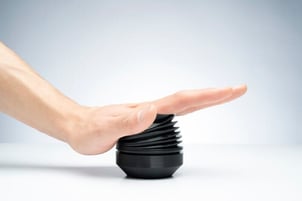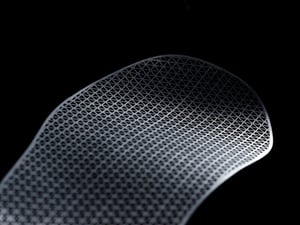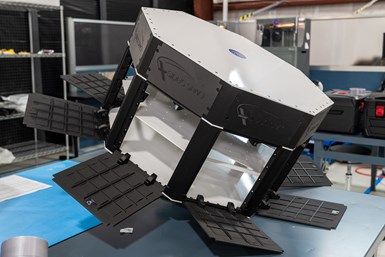Smooth TPU 95A! This material brings an entirely new set of functional properties to the Digital Forge and adds a substantial amount of versatility to what’s possible with Markforged 3D printers.
We started this program with the goal to provide world-class elastomeric part production to the additive manufacturing space — and after countless engineering hours and numerous iterations, we’re ready to release this truly differentiating product to the world. Manufacturers and product developers alike can now produce rubber-like material properties with the quality, consistency, and ease of use of the Digital Forge — all with minimal user interaction.
What is Smooth TPU? TPU (Thermoplastic Polyurethane) is a rubber-like material used to produce flexible, impact-absorbent parts. When you think of things like gaskets, seals, shock absorbers, hoses, and drive belts, TPU is one of a few materials used to produce these parts.
Markforged Smooth TPU is a 3D printing filament that provides the same functionality of traditionally manufactured parts while giving our users the capability to produce custom designs, on demand, at the point of need.

Economic Benefits of 3D Printing TPU The traditional methods of producing flexible, rubber-like materials can come with long lead times, expensive start-up costs, and multi-step processing. With the substantial tooling costs required, manufacturing with these types of materials is generally only feasible in high volumes. Smooth TPU 95A simplifies the process of creating flexible, rubber-like parts that are slow and expensive to obtain in low quantities.
With >500% elongation to break and a 95 ShoreA hardness, Smooth TPU is suitable for:
- Replacing traditional manufacturing to produce high-value, flexible, impact-resistant end-use parts when volume isn’t required
- Keeping production lines up when legacy parts are no longer available
- Prototyping for design validation before committing to scaling up production

3D Printing Elastomeric Materials with Confidence While the economic benefits of 3D printing TPU are clear, in practice, these filaments are finicky to print. They frequently cause jams, clogs and persistent printer adjustments from print-to-print. After all that frustration, the surface quality of a finished part is oftentimes very poor and unusable.
However, through excellent systems engineering work, we’ve merged our materials, hardware and software ingenuity to deliver a TPU printing solution that you can rely on. You won’t need an engineer to tweak print speeds, nozzle temps, or retract settings – we’ve done it all for you! And while there are several TPU-enabled additive manufacturing systems out there today, few, if any, provide the reliability, consistency, and ease of use that Markforged is bringing to the table. As with all Markforged materials, users simply click print and get back to work.

Functionality and Versatility of Smooth TPU One thing I love about the Smooth TPU solution is that it yields functional parts ready for industrial applications.
SLA and DLP TPU solutions may provide better feature fidelity, but these cured resin parts don’t stand-up to the loads and stresses of real-world applications. Alternatively, competitive FFF solutions may provide similar tensile and elongation properties, but can’t match the accuracy, consistency and surface quality of Smooth TPU.
At Markforged, we are bridging the gap to provide a solution that meets both the functional and high-quality needs of our customers. And by adjusting slicer settings, we can mimic the same flexibility of an 85 ShoreA gasket, a 90 ShoreA drive belt or a 95 ShoreA shock absorber all on the same spool of filament – Smooth TPU 95A.
To read the full article, click here.
Click here to learn more, get a quote, or contact an expert at The SolidExperts.


SUBMIT YOUR COMMENT